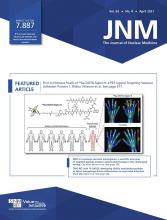Discussions with leaders: Jörg F. Debatin talks with Thomas Beyer about innovation in medicine and industry and the roles of leadership and team dynamics in health-care research and development.
Page 435
89Zr-immuno-PET: van Dongen and colleagues summarize state-of-the-art technical aspects of 89Zr-immuno-PET and outline its potential for steering the design, development, and application of biologic drugs.
Page 438
BMD in osteoporosis: Haseltine and colleagues provide an educational overview of the benefits and limitations of bone mineral density evaluation by dual-energy x-ray absorptiometry and the fracture risk assessment tool, as well as utility in monitoring osteoporosis therapy response.
Page 446
Agent optimization: Brechbiel looks at the challenges and promise of recent advances in targeted radiation therapy and at strategies to focus design and execution of research, funding, and publication to support continued development.
Page 455
Advances in ROS imaging: Espinoza and colleagues offer an overview of modern advances and modalities in the field of reactive oxygen species imaging, including the more recent introduction of nanoparticles.
Page 457
Editorial: Kesner comments on a recent JNM article comparing PET/MRI with PET/CT in whole-body staging and calls for more critical and broadly based evaluation of new technologies.
Page 462
18F-FET PET immunotherapy monitoring: Galldiks and colleagues investigate the value of 18F-FET PET for treatment monitoring of immune checkpoint inhibition or targeted therapy alone or in combination with radiotherapy in patients with brain metastases.
Page 464
Hypoxia and immune system in HNSCC: Nicolay and colleagues explore relationships between functional tumor hypoxia imaging and infiltrating lymphocyte levels as a potential predictor for treatment response in head-and-neck squamous cell carcinoma.
Page 471
18F-flubrobenguane PET in adrenal tumors: Kessler and colleagues report on a retrospective analysis assessing PET imaging with this novel radiotracer in pheochromocytomas and paragangliomas and investigating biodistribution in patients.
Page 479
PET/CT surveillance in esophageal cancer: Valkema and colleagues assess the value of serial 18F-FDG PET/CT scans for detecting local recurrence in patients beyond 3 months after neoadjuvant chemoradiotherapy and for determining when radiation-induced esophagitis has resolved.
Page 486
99mTc-ADAPT6 imaging of HER2: Bragina and colleagues detail the results of a first-in-humans study evaluating the biodistribution, dosimetry, and safety of this HER2-specific 99mTc–albumin-binding domain–derived affinity protein with potential for stratifying patients for therapies.
Page 493
ESR1 mutation PET: Kumar and colleagues investigate the effect of an activating ESR1 mutation on pretreatment 18F-FES uptake and early assessment of endocrine therapy response using 18F-FDG and 18F-FFNP PET/CT imaging of tumor glucose metabolism and progesterone receptor expression, respectively.
Page 500
PRRT in treatment-refractory meningioma: Mirian and colleagues detail the results of an individual patient data metaanalysis including all published data on meningioma patients treated with somatostatin receptor–targeted peptide-receptor radionuclide therapy.
Page 507
Interobserver agreement on SSTR-RADS 1.0: Werner and colleagues determine in a multicentric randomized setting the interobserver reliability of this standardized framework for interpreting somatostatin receptor–targeted PET/CT.
Page 514
PSMA radioligands with high tumor uptake: Kuo and colleagues develop improved prostate-specific membrane antigen–targeting radiotherapeutic agents that combine an optimized linker and optimized albumin binders to maximize tumor-to-kidney absorbed dose ratios.
Page 521
Synthetic projections and SPECT: Rydén and colleagues report on a study intended to decrease 177Lu SPECT acquisition time by reducing the number of projections and to circumvent image degradation by adding deep-learning–generated synthesized projections.
Page 528
TSPO PET with 18F-LW223: MacAskill and colleagues screen novel fluorinated 18-kDa translocator protein radiotracers for susceptibility to the rs6971 genetic polymorphism and assess 18F-LW223 suitability for clinical translation, including preclinical validation of macrophage-driven inflammation detection in myocardial infarction.
Page 536
Nigrostriatal connectivity in PD: Sanchez-Catasus and colleagues research associations between nigrostriatal tract integrity (defined by correlational tractography) and the degree of striatal dopaminergic denervation (based on 11C-DTBZ PET) in patients with Parkinson disease.
Page 545
M1 muscarinic acetylcholine receptor: Naganawa and colleagues report on a first-in-humans study of the PET radiotracer 11C-LSN3172176 for muscarinic acetylcholine receptor subtype M1, determining the appropriate kinetic model to quantify binding to M1 receptors and reliability of the quantification method.
Page 553
18F-SynVesT-1 and synaptic density: Naganawa and colleagues detail the results of a first-in-humans study of the kinetic and binding properties of this synaptic vesicle glycoprotein 2A radiotracer and compare it with 11C-UCB-J in quantitative measurement of synaptic density.
Page 561
Pediatric dose optimization: Prior and colleagues discuss the importance and benefits of dose optimization in pediatric nuclear medicine imaging and preview a related article in this issue of JNM.
Page 568
Optimization in pediatric studies: Poli and colleagues describe a 5-step optimization schema for pediatric radiology and nuclear medicine, developed and tested through an International Atomic Energy Agency coordinated research project.
Page 570
68Ga-DOTA-Siglec-9 PET: Viitanen and colleagues detail a first-in-humans study investigating the safety, tolerability, biodistribution, and radiation dosimetry of this sialic acid–binding immunoglobulinlike lectin 9 agent for imaging of inflammation.
Page 577
Radioprotection of GT3-loaded liposomes: Lee and colleagues report on a novel radioprotector drug, a liposomal formulation of γ-tocotrienol (GT3-Nano), to mitigate bone marrow radiation damage during targeted radionuclide therapy.
Page 584
- © 2021 by the Society of Nuclear Medicine and Molecular Imaging.







